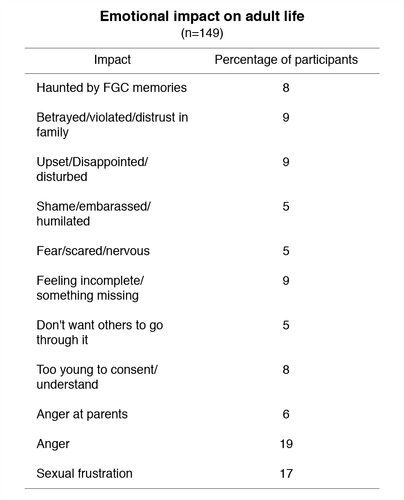A traumatic event is defined as direct or indirect exposure to actual or threatened death, serious injury or sexual violence.
The incident may be something that threatens the person’s life or safety, or the life of someone close to the victim. Traumatic incidents can include kidnapping, serious accidents such as car or train wrecks, natural disasters such as floods or earthquakes, or violent attacks such as rape, sexual or physical abuse, or FGC. As defined—although culturally sanctioned— FGC is a traumatic event.
Study conducted by Sahiyo
Although for some the consequences can be minimal, most of the evidence suggests that FGC is extremely traumatic and the physical or medical complications associated with FGC may remain acute or chronic. Early, life-threatening risks include hemorrhage, shock secondary to blood loss or pain, local infection and failure to heal, septicemia, tetanus, trauma to adjacent structures, and urinary retention. One of the more frequent longer-term medical consequences include adhesions or scarring, which can contribute to lingering pain and impede sexual functioning.
It has been reported that the psychological trauma that women experience through FGM often stays with them for the rest of their lives
(Equality Now and City University London, 2014, p.8).
The focus of FGC has long been regarded from a physical and medical perspective but it is equally important to consider the psychological and emotional implications of this practice.
Study conducted by Sahiyo
Usually the girl, unprepared for what is about to happen, is taken by surprise and cannot prevent what is about to occur. Those that can remember the ‘day they were cut’ often report having initially felt intense fear, confusion, helplessness, pain, horror, terror, humiliation and betrayal. Many have suffered a multi-phase trauma; the first being forced down and cut and then second is seeing or hearing another family member endure the procedure. Even anticipating the procedure, oneself can be terrifying. Also of significance is the community and family reaction to the painful reactions experienced by these young women. Often girls can be chided for crying and not being brave while undergoing the cutting. This dismissive, non-nurturing reaction can potentially lead to another facet of the multi-phase trauma.
Some proponents of FGC actually consider that the shock and trauma of the surgery may contribute to the behavior described as calmer and docile—considered to be positive feminine traits.
FGC is a traumatic event that can profoundly rupture an individual’s sense of self, safety, ability to trust and feel connected to others—aspects of life considered fundamental to well-being. Such genital violence can interrupt the process of developing positive self-esteem. And, when children are violated their boundaries are ruptured leading to feelings of powerlessness and loss of control. Children who have experienced trauma often have difficulty identifying, expressing and managing emotions, and may have limited language for describing their feelings and as a result they may experience significant depression, anxiety or anger.
Over time, if the distress can be communicated to people who care about the traumatized individual and these caretakers respond adequately, most people can recover from the traumatic event. But, some FGC affected girls and women experience severe distress for months or even years later.
The symptoms of trauma:
Outlined below are some of the consequences that may occur following a traumatic event. Sometimes these responses can be delayed, for months or even years after the event. Often, people do not even initially associate their symptoms with the precipitating trauma.
Physical
- Eating disturbances (more or less than usual)
- Sleep disturbances (more or less than usual)
- Sexual dysfunction
- Low energy
- Chronic, unexplained pain
Emotional/behavioral
- Depression, spontaneous crying, despair and hopelessness
- Anxiety; feeling out of control
- Panic attacks
- Fearfulness
- Feelings of ineffectiveness, shame, despair, hopelessness
- Irritability, angry and resentment
- Emotional numbness
- Withdrawal from normal routine and relationships
- Feeling frequently threatened
- Feeling damaged
- Self-destructive and impulsive behaviors
- Sexual problems
Cognitive
- Memory lapses, especially about the trauma
- Difficulty making decisions
- Loss of previously sustained beliefs
- Decreased ability to concentrate
- Feeling distracted
Over time, even without professional treatment, traumatic symptoms generally subside, and normal daily functioning gradually returns. However, even after time has passed, sometimes the symptoms don't go away. Or they may appear to be gone, but surface again in another stressful situation. When a person's daily life functioning or life choices continue to be affected, a post-traumatic stress disorder may be the problem, requiring professional assistance.
This is part once of a seven part series. To learn more about PTSD, check out Trauma and Female Genital Cutting Part 2--Post Traumatic Stress Disorder.


